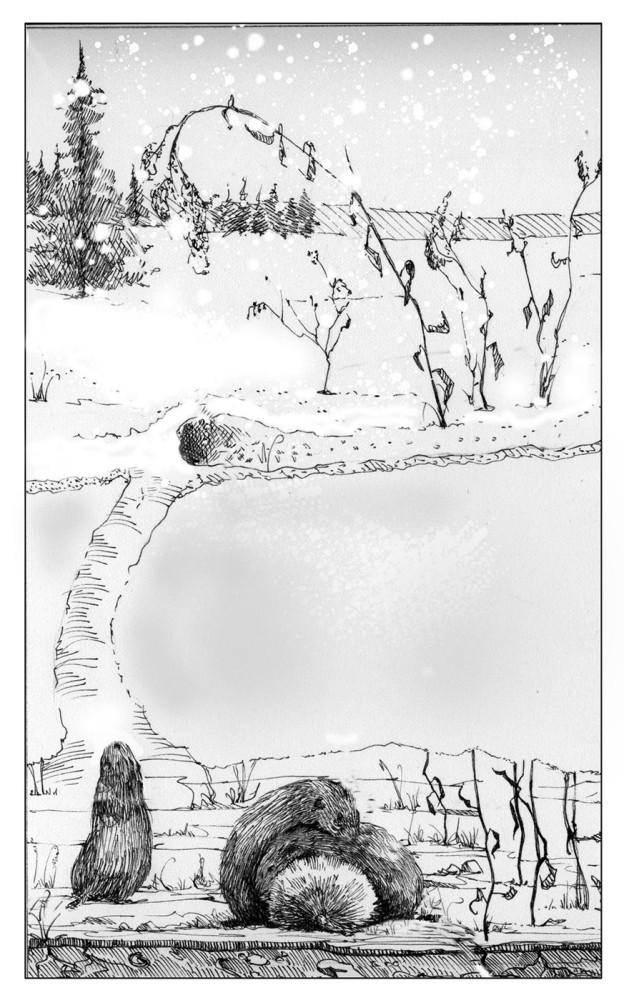
Bent down in an apple field searching for a lost earring, I found a different treasure: a stout mouse-like animal, with a short tail and stubby ears. It gave me one quick look, then disappeared through a maze of tunnels in the thick autumn grass. I would have loved to follow this meadow vole, like Alice and her white rabbit, to find out where it was planning to spend its winter.
I had come across vole signs before: twisting trails in melted snow and white skulls with yellow incisors revealed in owl pellets. But this was the first time I’d seen a living vole. An important food source for predators from fishers and bobcats to coyotes and even blue jays, meadow voles have an almost year-round ability to reproduce. Females mate as early as one month old, and some voles give birth to more than 17 litters in one year. With an average litter size of four to six pups, every four weeks between March and December, voles fuel the New England food web.
During winter, however, reproduction becomes secondary to surviving life in the cold. Voles, like many other mammals, stay active all winter long, but their strategy is markedly different than most others. Instead of hoarding food in secret caches or hibernating after bulking up, this rodent goes on a diet – and adjusts from a solitary being to a communal one.
In late summer, voles begin to eat less of their usual fare, which includes grasses, sedges, forbs, stems, and roots. By the time winter arrives, voles will have decreased their body mass by 20 percent. Most of this reduction takes place in organs like the liver, adrenal glands, and reproductive tissues, according to field biologist and author Peter Marchand. There is even evidence suggesting a reduction in brain size during winter.
This phenomenon of skinny meadow voles seems counter intuitive. Wouldn’t having less body mass to produce heat make it harder to stay warm? The vole’s shrinkage is only successful because it is accompanied by a complete shift in its social behavior.
During warmer seasons, meadow voles are aggressively solitary and will defend their home range from other voles. Author and ecologist Mark Elbroch describes them as “brawlers,” who consistently show nips and wounds from territorial scuffles. But in the winter, past conflicts are left behind, and voles huddle together in communal nests. Early in fall, voles begin to form group nests that are made up of extended family, comprising three to seven voles of varying ages and sex. As winter settles in and snow covers the landscape, these nests are protected by an insulating blanket of snow.
Below the snow, the social dynamics are fluid. Young voles and some adult males will disperse and join other nests, and the number of individuals in a nest will fluctuate. Researchers are not sure exactly why voles leave one nest to move to another, but they believe it could be related to predation – either moving after a predator has discovered one nest, or relocating proactively to avoid discovery.
When voles venture out of the nest to forage for food, they don’t all go at once. By leaving some voles at home while others seek food, the nest never completely loses warmth. This co-nesting gives them a thermal advantage.
How can a solitary and territorial vole become a social huddler, willing to snuggle with any warm group of voles? Research has shown that this is only possible because of hormonal changes triggered by the seasonal increase in the length of nighttime. During winter field studies, researchers from the University of California Berkeley discovered captured male meadow voles had reduced – or even non-existent – testes, and the majority of male and females had diminished production of sex hormones. Without these hormones fueling aggression between males for access to receptive females, and with the reduced appetite requirements limiting food competition, voles can coexist peacefully.
This winter under the snow, meadow voles will not be socially distancing. Instead, they’ll be tucked into their communal nests, keeping each other warm. On my many solo walks this winter, I will think of this small mammal’s ability to change its social behavior for the sake of survival.


Discussion *